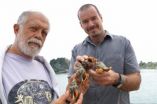(Press-News.org) Using an innovative tool that captures heretofore hidden ways that cells are regulated, scientists at Rockefeller University have identified a protein that makes breast cancer cells more likely to metastasize.
What's more, the protein appears to trigger cancer's spread in part by blocking two other proteins that are normally linked to neurodegeneration, a finding that suggests these two disease processes could have unexpected ties.
The study, which appears in the July 10 issue of Nature, points to the possibility of new cancer therapies that target this "master regulator" that helps set metastasis in motion.
"Although the research is in its very early days, if we learn more about how this regulation works, we may in the future be able to generate drugs that prevent this protein from triggering metastatic disease," says Sohail F. Tavazoie, senior author on the study. Tavazoie is Leon Hess Assistant Professor and head of the Vincent Meyer Laboratory of Systems Cancer Biology at Rockefeller.
During the study, Tavazoie and his colleagues used technology previously developed by first author Hani Goodarzi and co-author Saeed Tavazoie, a professor at Columbia University, to measure a new layer of regulation in cancer cells. In order to understand what triggers cells to become malignant, scientists often look at sequences of DNA, searching for genes which are turned on or off in cancerous cells. But in recent years, they've uncovered many new mechanisms that govern cell activity, including some that act on RNA, the genetic material that helps cells make proteins using instructions encoded in DNA. The special strength of Goodarzi and Saeed Tavazoie's tool is that it doesn't look simply at the sequence of RNA–it also looks at its shape.
It turns out, the shape of an RNA molecule matters. Specifically, some segments of messenger RNA form hairpin loops, which create sites for key proteins to bind to and regulate that RNA – telling the cell to destroy it, for instance. "These structural differences help determine RNA's fate, by exposing or hiding the binding sites for those key proteins," says Goodarzi.
So Goodarzi and Saeed Tavazoie developed a computer algorithm that scans samples of cancer cells and identifies patterns in the shapes and sequences of RNA. In the current study, the authors applied this algorithm to breast cancer cells. In cells prone to metastasis, for example, the scientists found certain RNA hairpin loops that were overrepresented in the sequences of RNAs targeted for destruction. They then identified a protein that binds to those hairpin sequences – TARBP2, known to play a role in the formation of small RNAs known as microRNAs. But here, it appears TARBP2 can also act as a "master regulator" of RNA itself, by binding to multiple sites and causing a suite of changes that lead to metastasis – including the destruction of the RNAs that carry those key binding sites. Indeed, they found that TARBP2 is overexpressed in cells prone to metastasizing, as well as in metastatic human breast tumors themselves.
To determine how TARBP2 carries out its effects, the researchers looked at which genes appear to be downregulated in metastatic cell lines, reasoning that TARBP2 may block these disease suppressors. They made two surprising discoveries – APP, a protein linked to Alzheimer's disease, and ZNF395, which is associated with Huntington's disease, are both downregulated by TARBP2. Cells prone to metastasis showed higher levels of TARBP2 and lower levels of APP and ZNF395; in cancer cells that tend not to spread throughout the body, the opposite was true.
"This was a surprising finding, because these genes are normally associated with neurodegeneration are now implicated in breast cancer metastasis and progression," says Tavazoie. "It's interesting that these totally disparate disease processes have a potential molecular link. We don't know what that means yet."
In further experiments, they discovered that ZNF395 appears to decrease the expression of genes linked to cancer, while one segment of APP directly inhibits breast cancer's ability to metastasize.
The study raises hopes of new cancer therapies that target this "master regulator," TARBP2. "If we can understand the mechanism by which TARBP2 interacts with RNA, maybe in the future we could generate drugs that prevent it from sitting on RNA structures and shutting down the genes that suppress metastatic disease," says Tavazoie.
Just what these findings say about the relationship between cancer and neurodegeneration – two of the most common diseases of old age – is still unclear, he adds. "All we can say here is that APP and ZNF395, besides being associated with neurodegeneration, also seem to play a functional role in the progression of breast cancer. We can't really make any statements about why this is – it could simply be that breast cancer cells use whatever mechanisms necessary to spread throughout the body, and these genes serve that purpose."
Of course, any future therapies that halt metastasis by blocking TARBP2 will have to sidestep the potential risk of promoting neurodegeneration in the process, cautions Goodarzi. All of that will have to be worked out in the lab, agrees Tavazoie.
Funding for the research was provided in part by the National Institutes of Health and the Department of Defense.
INFORMATION:
About Rockefeller University
Founded by John D. Rockefeller in 1901, The Rockefeller University was this nation's first biomedical research institution. Hallmarks of the university include a research environment that provides scientists with the support they need to do imaginative science and a truly international graduate program that is unmatched for the freedom and resources it provides students to develop their capacities for innovative research. The Rockefeller University Hospital, founded in 1910 as the first center for clinical research in the United States, remains a place where researchers combine laboratory investigations with bedside observations to provide a scientific basis for disease detection, prevention, and treatment. Since the institution's founding, Rockefeller University has been the site of many important scientific breakthroughs. Rockefeller scientists, for example, established that DNA is the chemical basis of heredity, identified the weight-regulating hormone leptin, discovered blood groups, showed that viruses can cause cancer, founded the modern field of cell biology, worked out the structure of antibodies, devised the AIDS "cocktail" drug therapy, and developed methadone maintenance for people addicted to heroin. Throughout Rockefeller's history, 24 scientists associated with the university have received the Nobel Prize in physiology/medicine and chemistry, and 21 scientists associated with the university have been honored with the Albert Lasker Medical Research Award. Five Rockefeller University scientists have been named MacArthur Foundation Fellows, and 20 have garnered the National Medal of Science. Currently, the university's award-winning faculty includes five Nobel laureates, seven Lasker Award winners and three recipients of the National Medal of Science. Thirty-four of the faculty members are elected members of the National Academy of Sciences. For more information, go to http://www.rockefeller.edu.
Protein pushes breast cancer cells to metastasize
Unexpected links to Alzheimer's disease and Huntington's disease also seen
2014-07-09
ELSE PRESS RELEASES FROM THIS DATE:
Not at home on the range
2014-07-09
As climate change shifts the geographic ranges in which animals can be found, concern mounts over the effect it has on their parasites. Does an increased range for a host mean new territory for its parasites as well?
Not necessarily, says a team of UC Santa Barbara scientists, including parasitologists Ryan Hechinger and Armand Kuris. In a study published in the Journal of Biogeography, Hechinger, Kuris and colleagues show that for some species, the opposite may happen: Hosts may actually lose their parasites when the hosts shift or increase their range. Theirs is one ...
New system would give individuals more control over shared digital data
2014-07-09
Cellphone metadata has been in the news quite a bit lately, but the National Security Agency isn't the only organization that collects information about people's online behavior. Newly downloaded cellphone apps routinely ask to access your location information, your address book, or other apps, and of course, websites like Amazon or Netflix track your browsing history in the interest of making personalized recommendations.
At the same time, a host of recent studies have demonstrated that it's shockingly easy to identify unnamed individuals in supposedly "anonymized" data ...
NASA, NOAA satellites help confirm Tropical Storm Fausto as a remnant low
2014-07-09
NOAA's GOES-West and NASA-JAXA's Global Precipitation Measurement or GPM mission satellite helped forecasters at the National Hurricane Center determine that what was once Tropical Storm Fausto is now a remnant area of low pressure in the Eastern Pacific Ocean.
Forecaster Beven at the National Hurricane Center (NHC) noted that "satellite imagery, overnight scatterometer data, and a recent GPM satellite microwave overpass indicate that Fausto has degenerated to a trough of low pressure."
On July 9 at 1500 UTC (11 a.m. EDT) Fausto's circulation was no longer apparent ...
Study identifies novel genomic changes in the most common type of lung cancer
2014-07-09
Researchers from The Cancer Genome Atlas (TCGA) Research Network have identified novel mutations in a well-known cancer-causing pathway in lung adenocarcinoma, the most common subtype of lung cancer. Knowledge of these genomic changes may expand the number of possible therapeutic targets for this disease and potentially identify a greater number of patients with treatable mutations because many potent cancer drugs that target these mutations already exist.
TCGA is jointly funded and managed by the National Cancer Institute (NCI) and the National Human Genome Research ...
Study cracks how the brain processes emotions
2014-07-09
ITHACA, N.Y. – Although feelings are personal and subjective, the human brain turns them into a standard code that objectively represents emotions across different senses, situations and even people, reports a new study by Cornell University neuroscientist Adam Anderson.
"We discovered that fine-grained patterns of neural activity within the orbitofrontal cortex, an area of the brain associated with emotional processing, act as a neural code which captures an individual's subjective feeling," says Anderson, associate professor of human development in Cornell's College ...
Bacteria hijack plentiful iron supply source to flourish
2014-07-09
In an era of increasing concern about the prevalence of antibiotic-resistant illness, Case Western Reserve researchers have identified a promising new pathway to disabling disease: blocking bacteria's access to iron in the body.
The scientists showed how bacterial siderophore, a small molecule, captures iron from two abundant supply sources to fan bacterial growth — as well as how the body launches a chemical counterassault against this infection process. Their findings appear in a recent edition of The Journal of Experimental Medicine.
"Bacterial siderophore will be ...
Climate change provides good growing conditions for charcoal rot in soybeans
2014-07-09
URBANA, Ill. – With over 100 diseases that can attack soybean crops, why would charcoal rot rise to the top of the most wanted list? University of Illinois scientists cite the earth's changing climate as one reason that more research is needed on the fungus that causes charcoal rot.
Fungi may often be associated with cool, damp growing conditions but Macrophomina phaseolina, the fungus that causes charcoal rot, prefers hot and dry drought conditions.
"As the climate continues to change and we see more extremes in the weather, including hotter, drier summers, this fungus ...
Biologists link sexual selection and placenta formation
2014-07-09
RIVERSIDE, Calif. — Sexual selection refers to species' selection for traits that are attractive to the opposite sex. This special type of natural selection enhances opportunities to mate, the tail of male peacocks being an iconic example.
Biologists at the University of California, Riverside have now found that sexual selection and "placentation" — the formation of a placenta — are linked. Describing the life histories of more than 150 species of fish in the family Poeciliidae, the researchers found that species with placentas tend to have males that do not have bright ...
USF study: Amphibians can acquire resistance to deadly fungus
2014-07-09
Tampa, Fla. (July 9, 2014) – Emerging fungal pathogens pose a greater threat to biodiversity than any other parasitic group, causing population declines of amphibians, bats, corals, bees and snakes. New research from the University of South Florida published in the prestigious journal Nature reveals that amphibians can acquire behavioral or immunological resistance to a deadly chytrid fungus implicated in global amphibian population declines.
"Acquired resistance is important because it is the basis of vaccination campaigns based on 'herd immunity', where immunization ...
Fox Chase researchers recommend updating the staging criteria for breast cancer diagnoses
2014-07-09
New findings from Fox Chase Cancer Center paint a relatively optimistic picture of women's chances of surviving a subset of breast cancers that have spread to the chest wall or skin, but not beyond.
Tumors that grow into the skin, regardless of size and whether they have involved lymph nodes, are automatically classified as stage III – and called "locally advanced" tumors, suggesting that they are a relatively serious form of cancer, often with poor survival. Locally advanced breast cancers of this and other types account for five to ten percent of new breast cancer ...
LAST 30 PRESS RELEASES:
Support for parents with infants at pediatric check-ups leads to better reading and math skills in elementary school
Kids’ behavioral health is a growing share of family health costs
Day & night: Cancer disrupts the brain’s natural rhythm
COVID-19 vaccination significantly reduces risk to pregnant women and baby
The role of vaccination in maternal and perinatal outcomes associated with COVID-19 in pregnancy
Mayo Clinic smartwatch system helps parents shorten and defuse children's severe tantrums early
Behavioral health spending spikes to 40% of all children’s health expenditures, nearly doubling in a decade
Digital cognitive behavioral treatment for generalized anxiety disorder
Expenditures for pediatric behavioral health care over time and estimated family financial burden
Air conditioning in nursing homes and mortality during extreme heat
The Alps to lose a record number of glaciers in the next decade
What makes a good proton conductor?
New science reporting guide published for journalists in Bulgaria
New international study reveals major survival gaps among children with cancer
New science reporting guide published for journalists in Turkey
Scientists develop a smarter mRNA therapy that knows which cells to target
Neuroanatomy-informed brain–machine hybrid intelligence for robust acoustic target detection
Eight SwRI hydrogen projects funded by ENERGYWERX
The Lundquist Institute and its start-up company Vitalex Biosciences Announces Strategic Advancement of Second-Generation fungal Vaccine VXV-01 through Phase 1 Trials under $40 Million Competitive Con
Fine particles in pollution are associated with early signs of autoimmune disease
Review article | Towards a Global Ground-Based Earth Observatory (GGBEO): Leveraging existing systems and networks
Penn and UMich create world’s smallest programmable, autonomous robots
Cleveland researchers launch first major study to address ‘hidden performance killer’ in athletes
To connect across politics, try saying what you oppose
Modulating key interaction prevents virus from entering cells
Project explores barriers to NHS career progression facing international medical graduates
Jeonbuk National University researchers explore the impact of different seasonings on the flavor perception of Doenjang soup
Two Keck Medicine of USC Hospitals named Leapfrog Top Teaching Hospitals
World-first discovery uncovers how glioblastoma tumours dodge chemotherapy, potentially opening the door to new treatments
A fatal mix-up: How certain gut bacteria drive multiple sclerosis
[Press-News.org] Protein pushes breast cancer cells to metastasizeUnexpected links to Alzheimer's disease and Huntington's disease also seen





